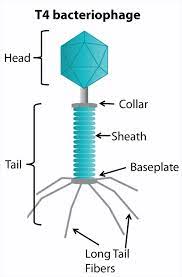Ch. 7 Viruses and Prions
1/42
There's no tags or description
Looks like no tags are added yet.
Name | Mastery | Learn | Test | Matching | Spaced |
|---|
No study sessions yet.
43 Terms
Viruses can be described as ___ or ___.
active; inactive
largest viruses
Pandoravirus; 1 micrometer
Mimivirus; 450 micrometers
smallest viruses
Parvoviruses .02 micrometers
Yellow fever virus 22 micrometers
capsid
shell surrounding viral nucleic acid
nucleocapsid
capsid and nucleic acid together
envelope
a modified piece of the host membrane; not found in all viruses
spikes
project from either the nucleocapsid or envelope; allow viruses to dock with their host cells
virion
fully formed virus able to establish infection in a host
capsomeres
identical protein subunits that spontaneously self assemble to form the capsid

helical capsid
rod-shaped capsomeres that form a continuous helix around the nucleic acid

icosahedral capsid
three-dimensional, 20 sided figure with 12 evenly spaced corners

complex capsids
. found in bacteriophage and rabies
. have multiple types of proteins
. take shaped that are not symmetrical
positive-sense RNA
single-stranded RNA genomes ready for immediate translation into proteins
negative -sense RNA
RNA genomes that need to be converted into the proper form to be made into proteins
polymerases
synthesize DNA and RNA
replicases
copy RNA
reverse transcriptase
synthesizes DNA from RNA
arenaviruses
pack along host ribosomes
retroviruses
“borrow” the host’s tRNA molecules
viral orders
suffix -virales
viral families
suffix -viridae
virus genera
suffix -virus
adsorption/attachment
virus encounters a susceptible host and adsorbs specifically to receptor sites on the cell membrane
host range
a virus can invade its host cell only through compatible host molecules
penetration
endocytosis: entire virus is engulfed the the cell and enclosed in a vacuole or vesicle
uncoating
enzymes in the vacuole dissolve the envelope and capsid, releasing the virus into the cytoplasm
synthesis
. viral nucleic acid takes control over the host’s synthetic and metabolic machinery
. Mechanism depends on whether the virus is a DNA or RNA virus
. RNA viruses replicate in the cytoplasm and DNA viruses replicate in the nucleus
release
. enveloped viruses are released by budding or exocytosis
cytopathic effects
virus-induced damage to the cell at alters its microscopic appearance
inclusion bodies
compacted masses of viruses or damaged cell organelles in the nucleus or cytoplasm
syncytia
fusion of multiple host cells into single large cells containing multiple nuclei
provirus
viral DNA incorporated into the DNA of the host
chronic latency state
periodic reactivation after a period of viral inactivity
oncogenic viruses
viruses that cause cancer; experts estimate that up to 13% of human cancers are caused by viruses
transformation
Virus carries genes that directly cause cancer; Virus produces proteins that induce a loss of growth regulation in the cell
bacteriophage
virus that infects bacteria; lytic and lysogenic cycles
lytic phase/ cycle
life cycle of a bacteriophage that ends in the destruction of the bacterial cell
lysogenic cycle
bacteriophage becomes incorporated into the host cell DNA
prophage: an inactive state in which phage DNA is inserted into the host chromosome
induction: activation of a prophage in a lysogenic cell to progress directly into viral replication and the lytic cycle
lysogenic conversion
the acquisition of a new trait from a temperate phage; responsible for the diphtheria toxin, cholera toxin, and botulism toxin
primary purposes of viral cultivation
isolate and identify viruses in clinical specimens
prepare viruses for vaccines
do detailed research on viral structure, multiplication cycles, genetics, and effects on host cells
benefits of using bird embryos for viral cultivation
. Embryonic development occurs in a protective shell
• Intact and self-supporting unit with its own sterile environment and nourishment
• Furnishes several embryonic tissues that support viral multiplication
continuous cell cultures
• Have altered chromosome numbers
• Grow rapidly
• Show changes in morphology
• Can be continuously subcultured if they are given fresh nutrient media
plaques
clear, well defied patches in the cell sheet that develops when viruses released from an infected cell radiate out to surround cells and infect them